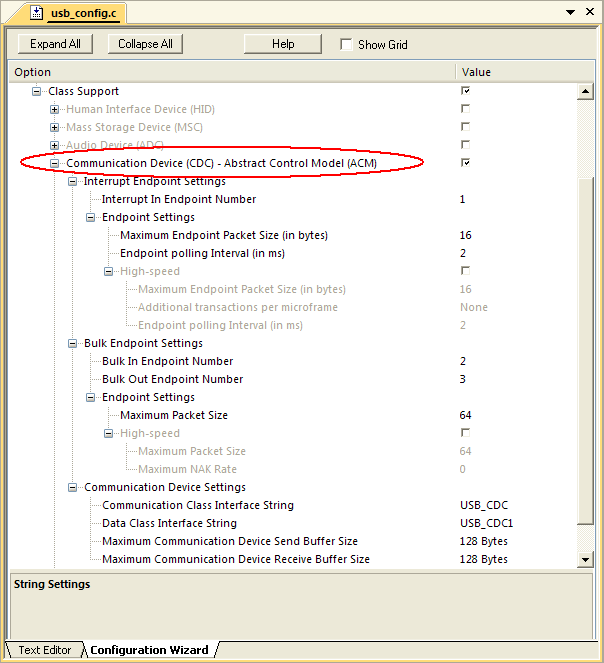|
||
| Products Download Events Support Videos | ||
Technical Support
On-Line Manuals
RL-ARM User's Guide (MDK v4)
Communication Device (CDC) - ACM Options
Communication Device (CDC) - Abstract Control Model (ACM) Options explains the configuration options for communication device of abstract control model type. The options can be edited in the file usb_config.c directly or using the µVision Configuration Wizard.

Where
-
Communication Device (CDC) - Abstract Control Model (ACM)
- enables class support for communication devices of abstract
control model type. This option corresponds to
#define USBD_CDC_ACM_ENABLE.
#define USBD_CDC_ACM_ENABLE 1 // 1=enabled; 0=disabled
Interrupt Endpoint Settings
configure the endpoint characteristics and affect the Endpoint Descriptor.
configure the endpoint characteristics and affect the Endpoint Descriptor.
-
Interrupt In Endpoint Number sets the endpoint number.
Values between 1..15 are allowed. This option corresponds to
#define USBD_CDC_ACM_EP_INTIN.
#define USBD_CDC_ACM_EP_INTIN 1 // value range 1..15
-
Maximum Endpoint Packet Size (in bytes) sets the maximal
packet size. Values between 0..1024 are allowed. This option
corresponds to #define USBD_CDC_ACM_WMAXPACKETSIZE.
#define USBD_CDC_ACM_WMAXPACKETSIZE 16 // value range 0..1024
-
Endpoint polling Interval (in ms) sets the data transfer
polling interval. Values from 0..255 are allowed. This option
corresponds to #define USBD_CDC_ACM_BINTERVAL.
#define USBD_CDC_ACM_BINTERVAL 2 // value range 0..255
-
High-speed enables the characteristics when using high
speed transfer rates. Enable the High Speed option under
USB Device. This
option corresponds to
#define USBD_CDC_ACM_HS_ENABLE.
#define USBD_CDC_ACM_HS_ENABLE 1 // 1=enabled; 0=disabled
-
Maximum Endpoint Packet Size (in bytes) sets the maximal
packet size for high speed transfers. Values between 0..1024
are allowed. This option corresponds to
#define USBD_CDC_ACM_HS_WMAXPACKETSIZE.
#define USBD_CDC_ACM_HS_WMAXPACKETSIZE 16 // next option also configures this macro
-
Additional transactions per microframe sets the
additional transaction packets for high speed transfers.
Discrete settings can be selected. This option also corresponds
to #define USBD_CDC_ACM_HS_WMAXPACKETSIZE.
#define USBD_CDC_ACM_HS_WMAXPACKETSIZE 16 // prev. option also configures this macro
-
Endpoint polling Interval (in ms) sets the data transfer
polling interval for high speed transfers. Discrete values can
be selected. This option corresponds to
#define USBD_CDC_ACM_HS_BINTERVAL.
#define USBD_CDC_ACM_HS_BINTERVAL 2 // value range 0..32768
Bulk Endpoint Settings
configure the endpoint characteristics and affect the Endpoint Descriptors.
configure the endpoint characteristics and affect the Endpoint Descriptors.
-
Bulk In Endpoint Number sets the endpoint number. Values
between 1..15 are allowed. This option corresponds to
#define USBD_CDC_ACM_EP_BULKIN.
#define USBD_CDC_ACM_EP_BULKIN 2 // value range 1..15
-
Bulk Out Endpoint Number sets the endpoint number.
Values between 1..15 are allowed. This option corresponds to
#define USBD_CDC_ACM_EP_BULKOUT.
#define USBD_CDC_ACM_EP_BULKOUT 2 // value range 1..15
-
Maximum Packet Size sets the maximal packet size, in
bytes. Values between 0..1024 are allowed. This option
corresponds to
#define USBD_CDC_ACM_WMAXPACKETSIZE1.
#define USBD_CDC_ACM_WMAXPACKETSIZE1 64 // value range 0..1024
-
High-speed enables the characteristics when using high
speed transfer rates. Enable the High Speed option under
USB Device. This
option corresponds to
#define USBD_CDC_ACM_HS_ENABLE1.
#define USBD_CDC_ACM_HS_ENABLE1 1 // 1=enabled; 0=disabled
-
Maximum Packet Size sets the maximal packet size, in
bytes, for high speed transfers. Values between 0..1024 are
allowed. This option corresponds to
#define USBD_CDC_ACM_HS_WMAXPACKETSIZE1.
#define USBD_CDC_ACM_HS_WMAXPACKETSIZE1 64 // value range 0..1024
-
Maximum NAK Rate sets the number for maximum not
acknowledged transfers. values between 0..255 are allowed. This
option also corresponds to
#define USBD_CDC_ACM_HS_BINTERVAL1.
#define USBD_CDC_ACM_HS_BINTERVAL1 0 // value range 0..255
Communication Device Settings
configure device specific options.
configure device specific options.
-
Communication Class Interface String sets the
communication interface string identifier. 126 characters are
allowed. This option corresponds to
#define USBD_CDC_ACM_CIF_STRDESC.
#define USBD_CDC_ACM_CIF_STRDESC L"USB_CDC" // up to 126 characters
-
Data Class Interface String sets the data interface
string identifier. 126 characters are allowed. This option
corresponds to #define USBD_CDC_ACM_DIF_STRDESC.
#define USBD_CDC_ACM_DIF_STRDESC L"USB_CDC1" // up to 126 characters
-
Maximum Communication Device Send Buffer Size sets the
maximal sending communication buffer size, in bytes. Discrete
values can be selected. This option corresponds to
#define USBD_CDC_ACM_SENDBUF_SIZE.
#define USBD_CDC_ACM_SENDBUF_SIZE 128 // possible values: 8, 16, 32, 64, 128, 256, 512, 1024
-
Maximum Communication Device Receive Buffer Size sets
the maximal receive buffer size, in bytes. It must not be less
then maximum packet size setting for the bulk out endpoint.
Discrete values can be selected. This option corresponds to
#define USBD_CDC_ACM_RECEIVEBUF_SIZE.
#define USBD_CDC_ACM_RECEIVEBUF_SIZE 128 // possible values: 8, 16, 32, 64, 128, 256, 512, 1024
Note
- The USB Device Controller hardware might impose restrictions on the use of endpoints.
- Refer to Create CDC ACM Applications for a quick-start on programming a USB CDC ACM Device.
ProductsDevelopment Tools |
Hardware & Collateral |
Downloads |
Support |
Contact |
